Low carbon behaviours framework: key behaviour areas - data for Scotland
Report on the uptake of our 10 low carbon key behaviour areas.
The Key Behaviour Areas – Home Energy
Home Energy
- The systems that heat our homes
- Keeping the heat in
- Managing home heating
- Saving electricity
Home Energy: Summary
- Monitoring energy use: there has been progress on the Key Behaviour Indicator for home energy. The percentage of households who monitor their energy use very or fairly closely has increased by 10 percentage points since 2008, to 54% in 2014.
- Heating Systems and Keeping the Heat In: there has been progress on one-off behaviours such as installing more energy efficient boilers, loft and cavity wall insulation, helped by various government support programmes. However, over half a million dwellings have uninsulated cavity walls, and another half a million dwellings have uninsulated solid walls.
- Heating management behaviours: of households with central heating systems and a time clock or thermostat, over 90% use one or both to manage their home heating. However less than half of people would put extra clothes on rather than turn heating up.
- Saving electricity: there has been steady progress in use of energy efficient light bulbs, and over 80% of people switch off lights in unused rooms always or very often. However, a third of people always leave their TV on standby overnight, and only 4 in 10 people wash clothes at less than 40 degrees Celsius.
Home Energy: Context
Home Energy Emissions by End Use - UK
Emissions from Housing account for 32% of GHG emissions from Scottish households, of which nearly 90% is attributable to Home Energy - an area where there is significant potential to reduce emissions*.
UK data** shows that:
- space and water heating together account for over three quarters of energy use in the home;
- Lighting, cooking and appliances account for almost a fifth of home energy use.
UK Domestic Final Energy Consumption by End Use: 2013**
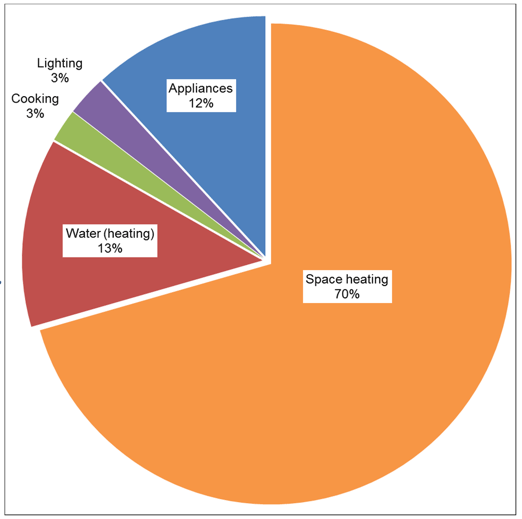
* Scottish Government (2016) Low carbon behaviours framework: method to estimate Scotland's greenhouse gas consumption emissions by theme
** BEIS (2016) Energy Consumption in the United Kingdom, Domestic Data Tables
NB: equivalent data for Scotland is not available
Home Energy: Key Indicator
Monitoring of home energy use
How closely households monitor their home energy use: 2008-2014*
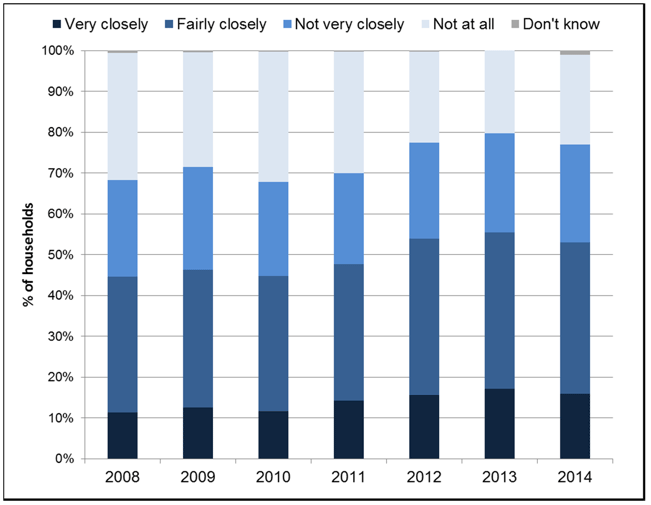
- 54% of households in Scotland state that they monitor their home energy use very or fairly closely, an increase of 10 percentage points between 2008 - 2014.
- However, this is only part of the picture. The following data provides a more comprehensive picture of how many households are taking action to reduce their energy use.
The systems that heat our homes
Household boiler types
- 84% of Scottish households use a gas or oil boiler as their primary source of heating*.
- Of those households, 48% have some type of condensing boiler, which is the most energy-efficient type - an increase from 7% in 2007*.
Boiler types in Scotland: 2005/06 - 2014*

Small-scale renewable energy generation
Around 2% of Scottish households are using renewable energy from microgeneration - small-scale, household or local sources such as solar panels or hydro schemes .
Of these small-scale installations, in 2014, solar panels were the most common type.
NB: households can have more than 1 kind of installation.
Small-scale renewable energy generation by source, 2014*
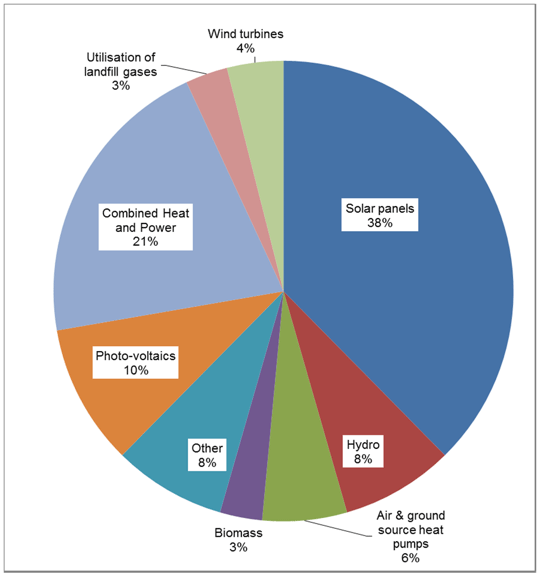
* Scottish Government (2015) Scottish Household Survey, 2014
Keeping the Heat In
External Wall Insulation: cavity and solid walls
Uninsulated dwellings are estimated to lose a third of their heat through their walls. In Scotland, around ¾ of external walls are cavity walls and ¼ are solid or other wall types.*
Cavity walls: between 2007 to 2014, the proportion of insulated cavity walls has increased significantly, from 53% to 71%. However around 518,000 dwellings still have uninsulated cavity walls.
Solid / other walls: a relatively small proportion of these walls are insulated - only 14% in 2014, up from 9% in 2007. Around 528,000 dwellings still have uninsulated solid walls.
Dwellings with external wall insulation, 2007 to 2014*
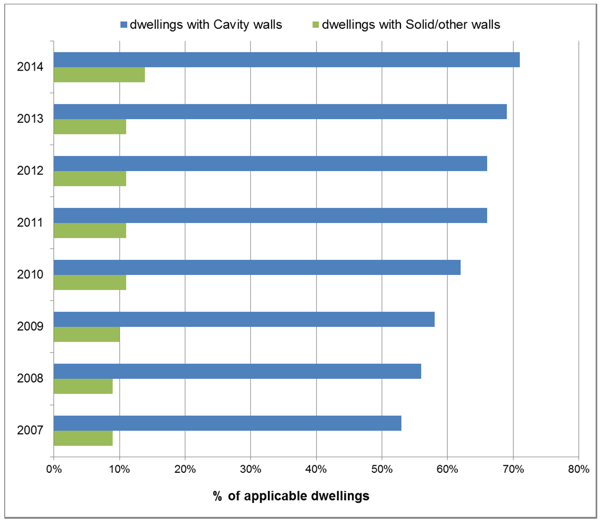
Loft Insulation: lofts with 200mm or more insulation
It is estimated that in an uninsulated dwelling, a quarter of all heat is lost through the roof.
In 2014, 62% of dwellings (over 1.1 million homes) had 200mm or more of loft insulation. This compares with 14% in 2003/04 (258,000 homes). Only 1% of dwellings with lofts now have no insulation at all.
Depth of loft insulation, 2003/04 to 2014*
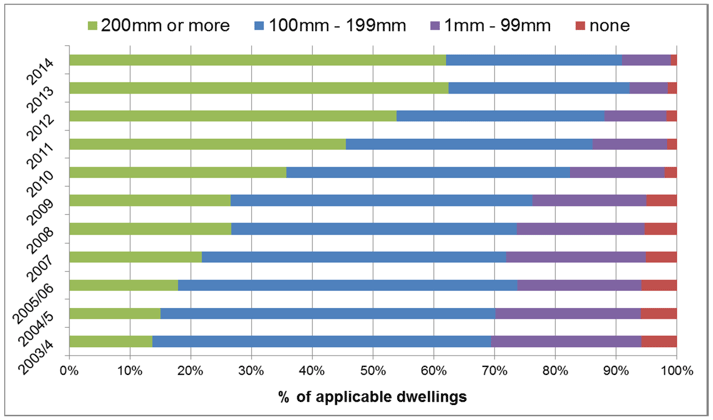
NB: the recommended depth for loft insulation using mineral wool, the most common type, is 270mm.**
* Scottish Government (2015) Scottish House Condition Survey, 2014 (based on data from Scottish Household Survey, 2014)
** Energy Saving Trust website
Window Glazing: homes with double glazing
Homes with double glazing, 2005/06 - 2014*

The proportion of homes with double glazing has risen from 88% in 2005/06 to 93% in 2014.
Two thirds of installations occurred prior to 2003** and could be less efficient than newer ones.
The proportion of homes without double or triple glazing has been falling steadily. This is a good example of an energy saving behaviour that has become a 'norm' for householders.
* Scottish Government (2015) Scottish House Condition Survey, 2014 (based on data from Scottish Household Survey, 2014)
** Scottish Government (2012) Scottish House Condition Survey - Energy Use in the Home
Managing home heating
Management of home central heating systems
95% of dwellings in Scotland have a full central heating system and 3% a partial system (these figures include the 12% of dwellings with storage heating)*.
Of households with central heating, over three-quarters have either a thermostat or a time clock or both; and the proportion of people who say they use them to adjust their heating has been increasing over time. In 2014:
* Time clocks: 79% of householders have one, of whom 90% say they use it.
* Thermostats: 84% of householders have one, of whom 91% say they use it.
Households with a thermostat and/or time clock who use them to manage their central heating systems: 2007-2014**
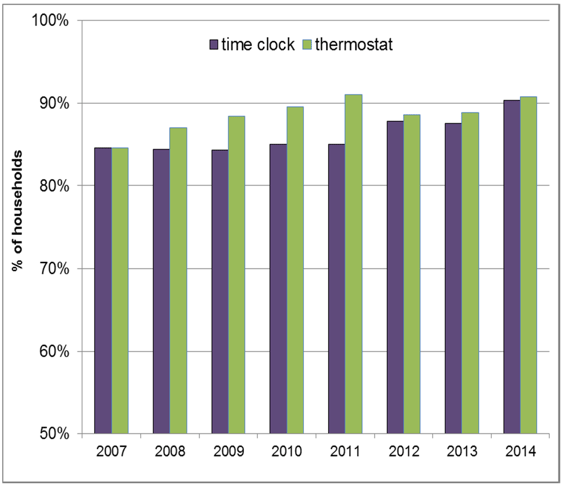
* Scottish Government (2012) Scottish House Condition Survey - Energy Use in the Home
** Scottish Government (2015) Scottish Household Survey, 2014
People who put on more clothes rather than putting on or turning up heating
There is potential for households to save energy by people putting on more clothes rather than turning the heating on or up, though this might not be appropriate for all households.
Less than half of people in Scotland would always or very often put more clothes on rather than turning the heating on or up.
This proportion was fairly consistent between 2009/10 (46%) and 2012/13 (49%).
People who put on more clothes when feeling cold rather than putting on or turning up the heating, 2009/10 & 2012/13*

* Understanding Society: The UK Household Longitudinal Study : Survey Waves 1 and 4
Households not heating all rooms in winter
There is potential for households to save energy by focusing heat on rooms in most use, and avoiding overheating rooms which are in less use, though this might not be appropriate for all households.
Just over 1 in 4 Scottish households turn the heating off in unused rooms during winter, both weekdays and weekends. These figures have hardly changed over the past 10 years.
Households who do not heat all rooms in winter, 2007-2014*

* Scottish Government (2015) Scottish Household Survey, 2014
Saving electricity
Use of low energy lighting
Household use of low energy fixed light fittings: 2007-2014*
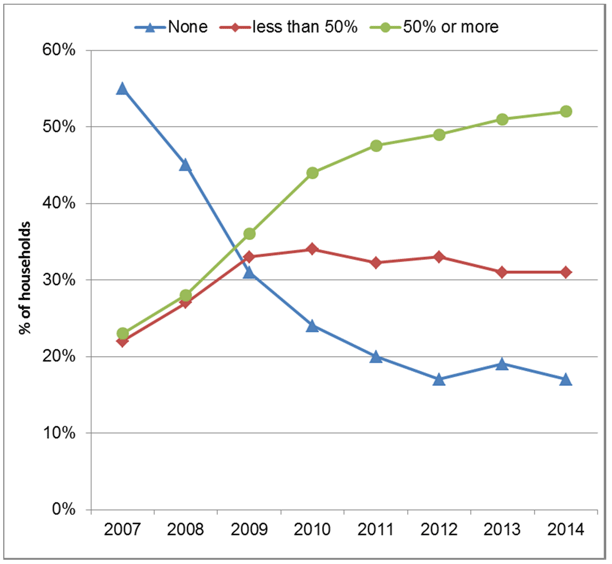
Households with:
- No low energy lighting: the percentage more than halved, from 55% in 2007 to 17% in 2014.
- 50% or more low energy lighting: the percentage more than doubled in the same period, from 23% to 52%.
- 100% low energy lighting: applied to only 13% of households in 2014.
Switching off lights in unused rooms
Almost two thirds of people say they always switch lights off in rooms that are not being used. This proportion was unchanged between 2009/10 and 2012/13.
A further 1 in 5 do this very often, with little change between the same two periods.
Only 5% of people never or rarely switch lights off.
People who switch off lights in unused rooms: 2009/10 and 2012/13*
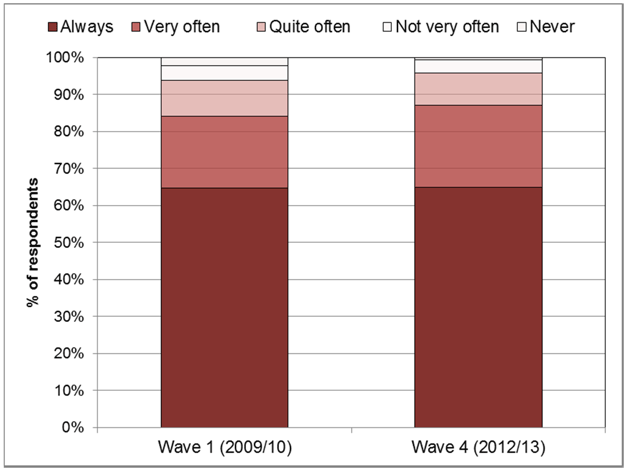
* Understanding Society: The UK Household Longitudinal Study : Survey Waves 1 and 4
Fully turning off the TV overnight
People who leave the TV on standby, 2009/10 and 2012/13*

Half of people never leave their TV on standby overnight (2012/13) - however this represents a decrease from 57% in 2009/10.
29% of people always leave their TV on standby overnight - and this represents an increase from 23% in 2009/10.
* Understanding Society: The UK Household Longitudinal Study : Survey Waves 1 and 4
Washing clothes at less than 40 degrees
Temperature people wash their clothes at, 2011*
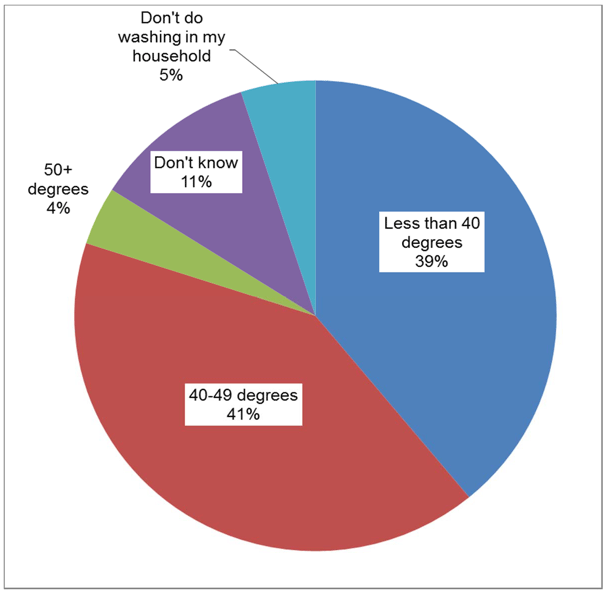
2 in 5 Scots wash their clothes at less than 40 degrees*
According to the Energy Saving Trust, washing clothes at 30 degrees rather than at higher temperatures uses around 40% less energy.**
* Zero Waste Scotland/ WRAP 3Rs tracker, Autumn 2011
** Energy Saving Trust website
Contact
There is a problem
Thanks for your feedback